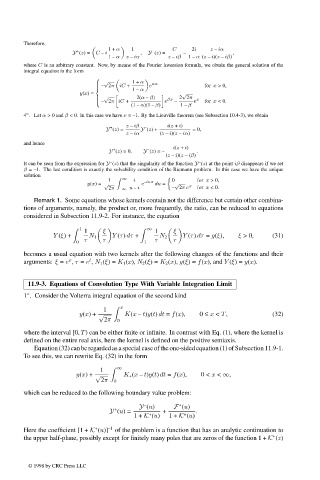Page 575 - Handbook Of Integral Equations
P. 575
Therefore,
1+ α 1 C 2i z – iα
–
+
Y (z)= C – i , Y (z)= – ,
1 – α z – iα z – iβ 1 – α (z – i)(z – iβ)
where C is an arbitrary constant. Now, by means of the Fourier inversion formula, we obtain the general solution of the
integral equation in the form
√ 1+ α
– 2π iC + e αx for x >0,
1 – α
y(x)=
√
√ 2(α – β) 2 2π
– 2π iC + e – e for x <0.
βx x
(1 – α)(1 – β) 1 – β
4 . Let α > 0 and β < 0. In this case we have ν = –1. By the Liouville theorem (see Subsection 10.4-3), we obtain
◦
z – iβ i(z + i)
+
–
Y (z)= Y (z)+ =0,
z – iα (z – i)(z – iα)
and hence i(z + i)
+
–
Y (z)=0, Y (z)= – .
(z – i)(z – iβ)
–
–
It can be seen from the expression for Y (z) that the singularity of the function Y (z) at the point iβ disappears if we set
β = –1. The last condition is exactly the solvability condition of the Riemann problem. In this case we have the unique
solution
1 ∞ i –iux 0 for x >0,
y(x)= √ e du = √ x
2π –∞ u – i – 2πe for x <0.
Remark 1. Some equations whose kernels contain not the difference but certain other combina-
tions of arguments, namely, the product or, more frequently, the ratio, can be reduced to equations
considered in Subsection 11.9-2. For instance, the equation
1 1 ∞ 1
ξ
ξ
Y (ξ)+ N 1 Y (τ) dτ + N 2 Y (τ) dτ = g(ξ), ξ > 0, (31)
0 τ τ 1 τ τ
becomes a usual equation with two kernels after the following changes of the functions and their
t
x
arguments: ξ = e , τ = e , N 1 (ξ)= K 1 (x), N 2 (ξ)= K 2 (x), g(ξ)= f(x), and Y (ξ)= y(x).
11.9-3. Equations of Convolution Type With Variable Integration Limit
1 . Consider the Volterra integral equation of the second kind
◦
x
1
y(x)+ √ K(x – t)y(t) dt = f(x), 0 ≤ x < T, (32)
2π 0
where the interval [0, T) can be either finite or infinite. In contrast with Eq. (1), where the kernel is
defined on the entire real axis, here the kernel is defined on the positive semiaxis.
Equation (32) can be regarded as a special case of the one-sided equation (1) of Subsection 11.9-1.
To see this, we can rewrite Eq. (32) in the form
∞
1
y(x)+ √ K + (x – t)y(t) dt = f(x), 0 < x < ∞,
2π 0
which can be reduced to the following boundary value problem:
–
+
Y (u) F (u)
+
Y (u)= + .
+
+
1+ K (u) 1+ K (u)
+
Here the coefficient [1 + K (u)] –1 of the problem is a function that has an analytic continuation to
+
the upper half-plane, possibly except for finitely many poles that are zeros of the function 1 + K (z)
© 1998 by CRC Press LLC
© 1998 by CRC Press LLC
Page 558

